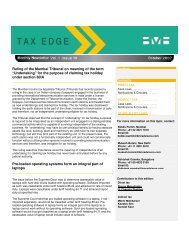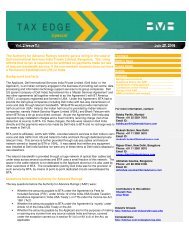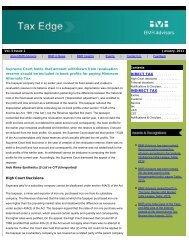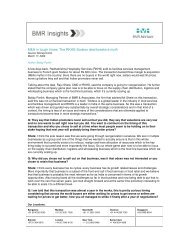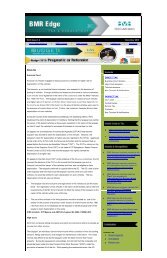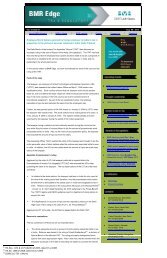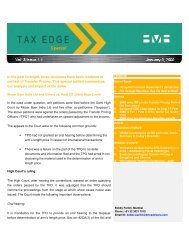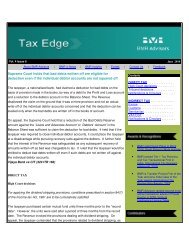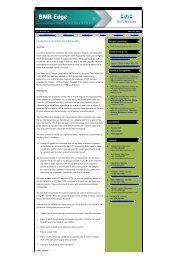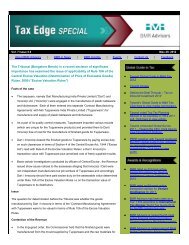Corporate Tax 2010 - BMR Advisors
Corporate Tax 2010 - BMR Advisors
Corporate Tax 2010 - BMR Advisors
Create successful ePaper yourself
Turn your PDF publications into a flip-book with our unique Google optimized e-Paper software.
Slaughter and May<br />
United Kingdom<br />
3.5 If so, is there a “safe harbour” by reference to which tax<br />
relief is assured<br />
There are no statutory safe harbour rules. In <strong>Tax</strong> Bulletin 17 of<br />
1995, however, the Inland Revenue, as they were then called,<br />
explained their practice of accepting that where a loan otherwise<br />
meets the arm’s length test, a company will not be thinly capitalised<br />
where:<br />
the level of debt to equity does not exceed a ratio of 1:1; and<br />
its income to interest cover is at least 3:1.<br />
The <strong>Tax</strong> Bulletin emphasised, however, that there are no hard and<br />
fast rules in this area and that each case has to be considered on its<br />
own facts. This is reaffirmed in the International Manual at<br />
INTM579040.<br />
3.6 Would any such “thin capitalisation” rules extend to debt<br />
advanced by a third party but guaranteed by a parent<br />
company<br />
received by a UK company will now, subject to some exceptions,<br />
be exempt from corporation tax.) For more details about the<br />
taxation of dividends see Chapter 1 by Graham Airs.<br />
3.8 Does the United Kingdom have transfer pricing rules<br />
Yes. Since 1 April 2004, the transfer pricing rules have applied to<br />
both cross-border and domestic transactions between associated<br />
companies.<br />
If HMRC do not accept that pricing is arm’s length they will raise<br />
an assessment adjusting the profits or losses accordingly. It is<br />
possible to make an application to HMRC for an advance pricing<br />
agreement which has the effect that pricing in accordance with its<br />
terms is treated as arm’s length.<br />
In cross-border transactions the double taxation caused by a transfer<br />
pricing adjustment can be mitigated by the provisions of a tax<br />
treaty.<br />
United Kingdom<br />
Yes. A company may be thinly capitalised because of a special<br />
relationship between the borrower and the lender or because of a<br />
guarantee given by a person connected with the borrower. The UK<br />
legislation contains a wide definition of the word “guarantee” and<br />
includes any case in which the lender has a real expectation that he<br />
will be paid by, or out of the assets of, another connected company.<br />
There is no requirement for a guarantee to be in writing.<br />
The legislation gives a compensating adjustment to a guarantor in<br />
circumstances where interest has been disallowed because of the<br />
guarantee. The effect of the rule is to treat the guarantor as if the<br />
guarantor had taken the loan and paid the interest instead of the<br />
actual borrower. The guarantor will obtain a tax deduction for the<br />
interest provided it meets the usual conditions for an interest<br />
deduction. The effect where the borrower and the guarantor are<br />
both subject to UK tax is, therefore, neutral.<br />
3.7 Are there any restrictions on tax relief for interest<br />
payments by a local company to a non-resident in addition<br />
to any thin capitalisation rules mentioned in questions<br />
3.4-3.6 above<br />
The Finance Act 2009 has introduced, with effect for accounting<br />
periods beginning on or after 1 January <strong>2010</strong>, a further restriction<br />
on tax relief for finance expenses of groups of companies in certain<br />
circumstances. The new “worldwide debt cap”, as it is known,<br />
limits the aggregate UK tax deduction for the UK members of a<br />
group that have net finance expenses to the worldwide consolidated<br />
gross finance expense of that group. The intention behind the new<br />
legislation is to prevent groups “dumping” debt in the UK in order<br />
to achieve a UK tax deduction.<br />
The complex legislation contains a “gateway test” which is<br />
intended to be more simple to apply than the full regime. The<br />
gateway test simply compares the aggregate of the average net debt<br />
of each UK company for an accounting period with the average<br />
worldwide gross debt income. If the aggregate UK net debt does<br />
not exceed 75% of the worldwide gross debt then the debt cap<br />
provisions need not be considered further.<br />
Financial services groups fall outside the new rules if certain<br />
conditions are met.<br />
The worldwide debt cap is intended to pay, in part, for the tax<br />
exemption for foreign dividend income which has been introduced<br />
by the Finance Act 2009. (Prior to the Finance Act 2009, dividends<br />
received by a UK company from another UK company were<br />
exempt from tax but foreign dividends were taxable. All dividends<br />
ICLG TO: CORPORATE TAX <strong>2010</strong><br />
© Published and reproduced with kind permission by Global Legal Group Ltd, London<br />
4 <strong>Tax</strong> on Business Operations: General<br />
4.1 What is the headline rate of tax on corporate profits<br />
The headline rate of tax is currently 28%.<br />
4.2 When is that tax generally payable<br />
For companies other than “large” companies, corporation tax is due<br />
and payable nine months after the end of the accounting period for<br />
tax purposes.<br />
Large companies are generally companies with profits in the<br />
accounting period in question in excess of £1.5m, but this £1.5m<br />
threshold is proportionately reduced if there are associated<br />
companies or the accounting period is less than 12 months. Large<br />
companies have to pay corporation tax in quarterly instalments<br />
based on an estimate of the tax they are likely to pay. The first<br />
instalment payment is due 6 months and 13 days from the start of<br />
the accounting period and the last instalment (which will be the<br />
balance of the corporation tax liability) is due 3 months and 14 days<br />
from the end of the accounting period.<br />
4.3 What is the tax base for that tax (profits pursuant to<br />
commercial accounts subject to adjustments; other tax<br />
base)<br />
In general terms, the tax follows the commercial accounts subject to<br />
adjustments.<br />
4.4 If it otherwise differs from the profit shown in commercial<br />
accounts, what are the main other differences<br />
Certain items of expenditure which are shown as reducing the<br />
profits in the commercial accounts are added back for tax purposes<br />
and deductions for tax purposes may then be allowable. For<br />
example, in the case of depreciable plant or machinery, capital<br />
allowances on a reducing balance basis at various rates depending<br />
on the type of asset and the level of expenditure incurred) are<br />
substituted for accounting depreciation.<br />
The UK tax legislation has been amended to deal with various<br />
issues arising from companies adopting International Accounting<br />
Standards to draw up commercial accounts for accounting periods<br />
beginning on or after 1 January 2005 and in certain circumstances,<br />
WWW.ICLG.CO.UK 261







